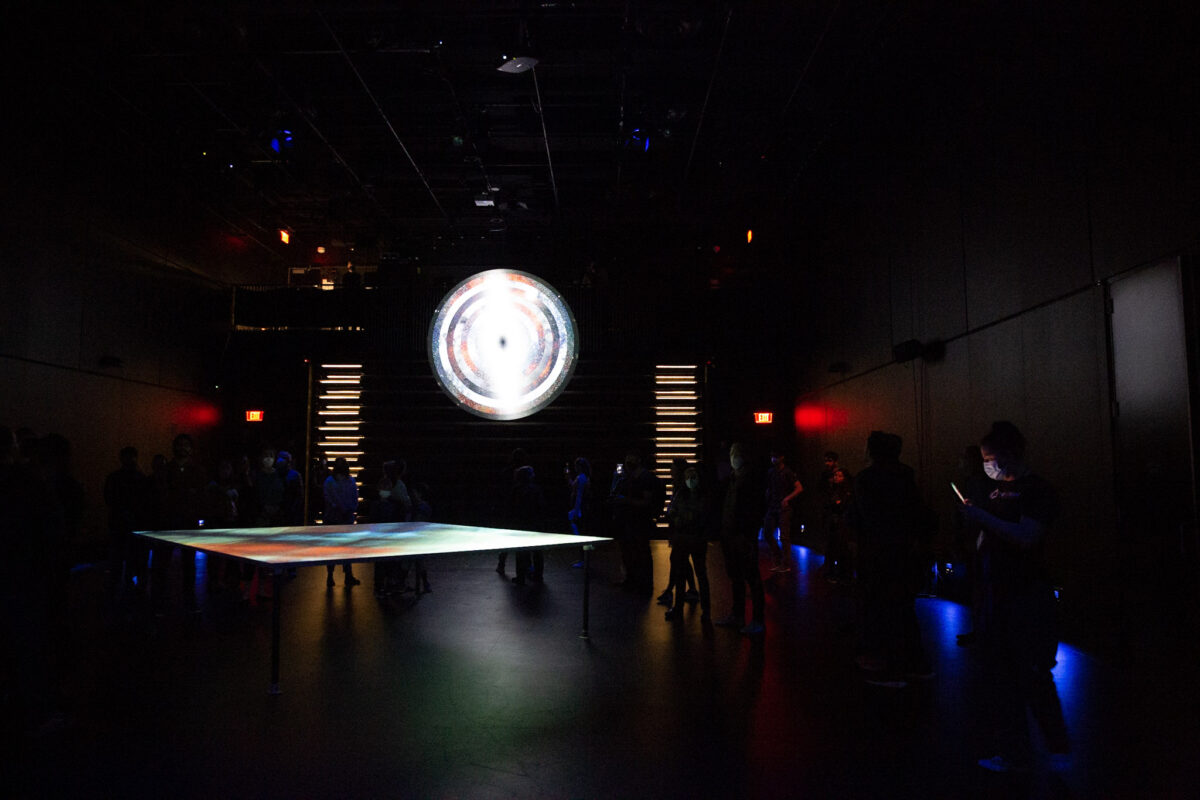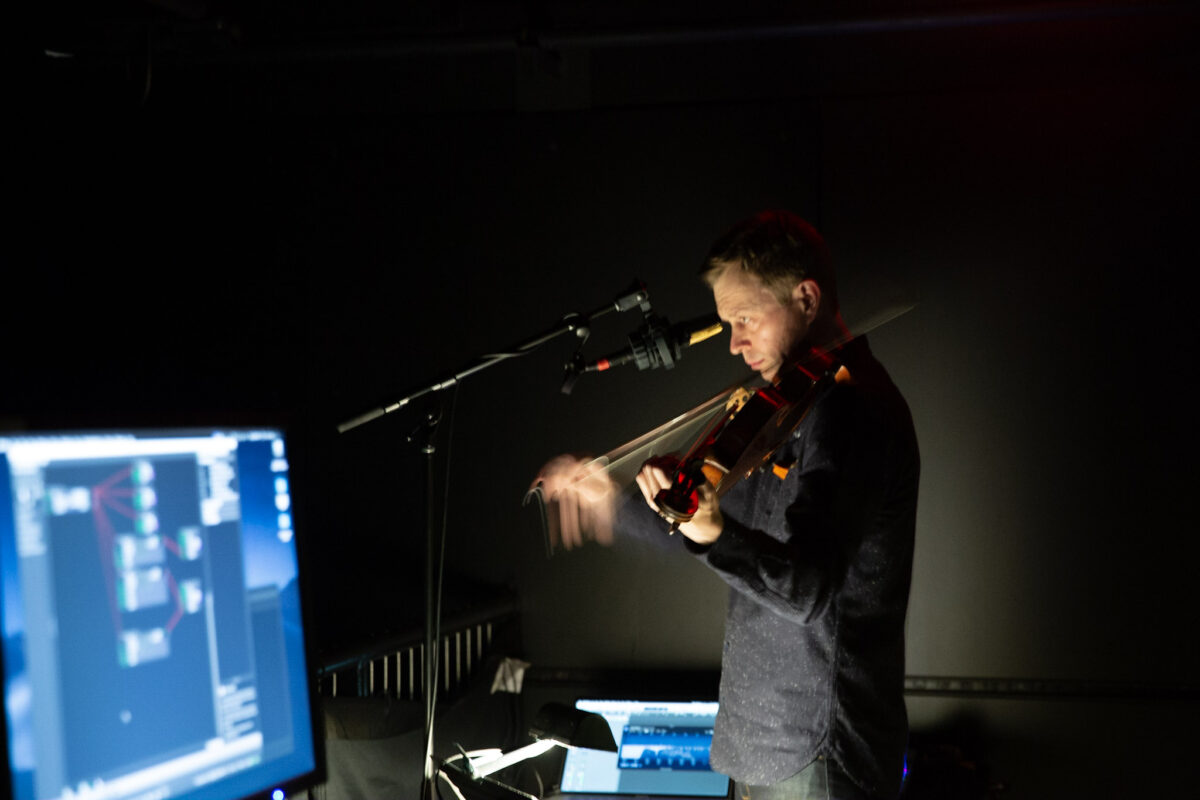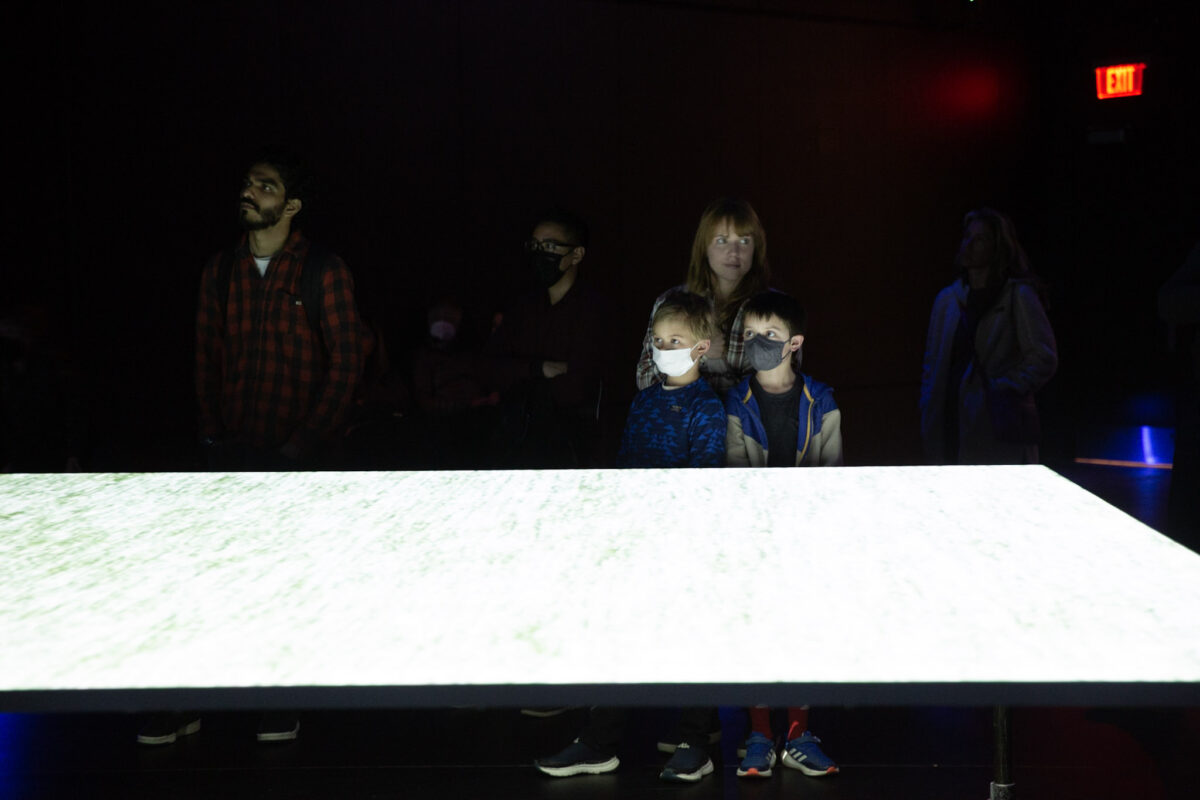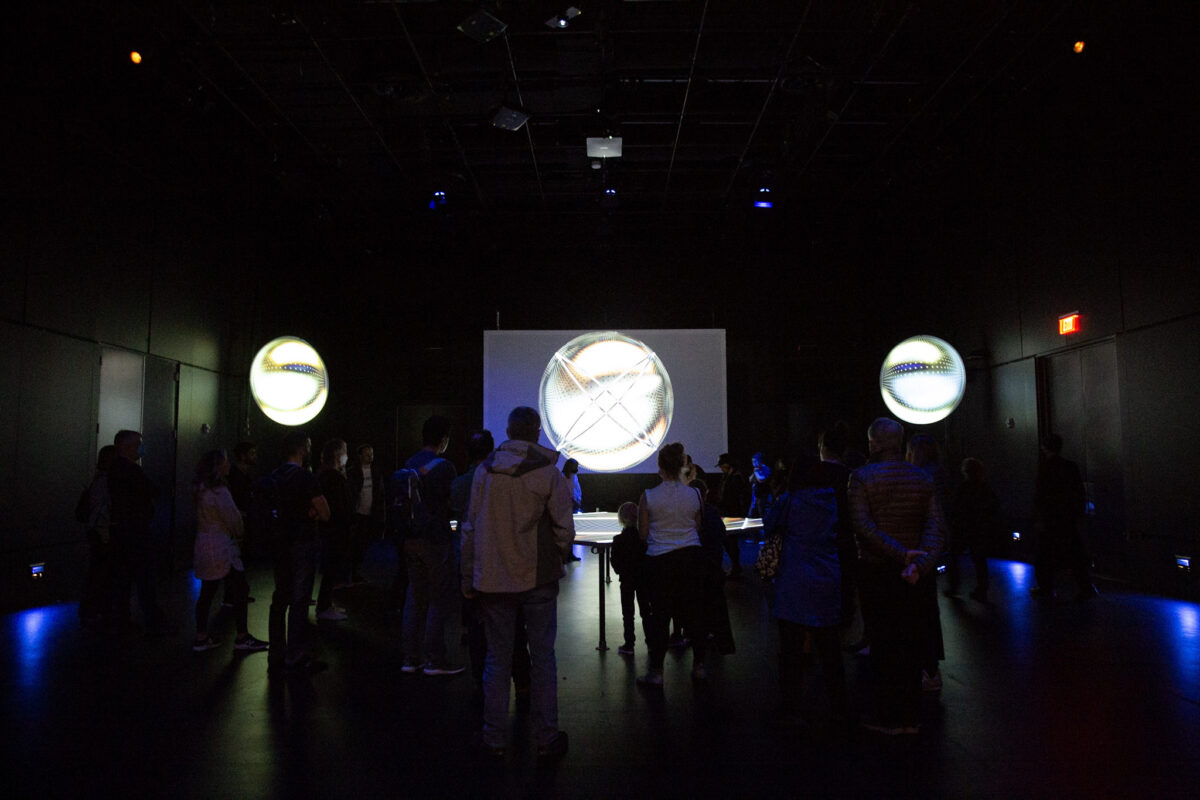A musician and a visual artist immerse their audience in the science and spirituality of gravity
“How ’bout that!” It’s a mild exclamation for a historic moment on the surface of the Moon. In the grainy footage from NASA’s 1971 Apollo 15 mission, astronaut David Scott utters these words after dropping a hammer and a feather side by side, thereby confirming Galileo Galilei’s centuries-old assertion that all objects in a vacuum fall at the same rate.
The Hammer and the Feather, an immersive audio and video installation presented on May 4 and 5 by the MIT Center for Art, Science & Technology (CAST) and MIT Music and Theater Arts, includes only a brief, silent glimpse of this NASA footage. For the project’s lead artist, Christian Frederickson, the titular demonstration that “gravity affects everyone and everything the same” was a jumping-off point for a deeper dive into science, faith, and the nature of existence.
Frederickson arrived at MIT in 2019 to teach theatrical sound design. A classically trained violist and composer, he was eager to use his time at the Institute to create a musical work rooted in science and technology. He recruited his longtime artistic colleague, filmmaker and artist Gregory King, to craft visuals for the piece. Supported by a 2020–21 Fay Chandler Creativity Grant from MIT CAST, the duo transformed the black box theater in MIT’s Building W97 into a contemplative space through which audience members could move freely—as Frederickson puts it, “remixing” the audio and visual elements for themselves.
The scientific and the sacred
Some audience members might leave The Hammer and the Feather feeling like they’ve journeyed through outer space, others like they’re emerging from a church. Frederickson wants each individual to have a unique experience of the work.
“That’s something that we’re trying to foster in the arts at MIT,” he notes. He aims to help his students become “comfortable with abstract and sometimes ambiguous interpretations.”
Frederickson intended to construct the installation around data and math related to gravity, but his research turned toward the history of scientists like Galileo, Newton, and Einstein who sought understanding of this fundamental force. He also discovered the writings of former MIT professor Giorgio de Santillana, who’d made connections between the beginnings of astronomy and the myth-making of ancient cultures and religions. Scientific and spiritual inquiry, Frederickson realized, are parallel attempts to make sense of the universe. “I don’t think they are exclusive, or they aren’t for me, though there are elements of conflict and contradiction,” he says.
“If one accepts that a creator made the universe,” his collaborator King suggests, “then the work of science is actually a sacred pursuit.” King is the kind of physics enthusiast who views the Large Hadron Collider as “a work of deep, profound beauty”; religion has also played an important role in his life. “The juxtaposition of the two spheres offers an interesting resonance I don’t often see in the art and theater world,” he says.
Frederickson used the liturgical mass to structure the five movements of The Hammer and the Feather, but bypassed explicitly Christian references to explore the mass’s universal sentiments. For example, he believes kyrie, a plea for divine mercy, is motivated “by a feeling all humans share of not measuring up.” The Covid-19 pandemic delayed the project, and as its toll mounted worldwide, he found solace and further inspiration in masses of requiem. The only spoken text in The Hammer and the Feather is a litany of names of those lost to the virus.
Fusing sight and sound
King is based in Los Angeles, so the artists’ collaboration unfolded via Zoom and Dropbox. Only when King arrived in Cambridge roughly two weeks before the premiere did they fully combine the elements they’d been bouncing off each other from opposite coasts. The long-distance process was enabled by a “shared vocabulary,” Frederickson says, from a decades-long association. The two met in Louisville, Kentucky, in the 1990s and toured together through 2006 as part of the instrumental band Rachel’s, which was influenced by minimalist composers such as Philip Glass, Michael Nyman, Steve Reich, and Terry Riley. Frederickson played the viola and King used projectors and screens to accompany the group’s music with images he’d shot and manipulated. During Frederickson’s subsequent career as a solo artist and theatrical sound designer, he composed music for some of King’s films.
For The Hammer and the Feather, King brainstormed imagery to bridge Frederickson’s scientific and spiritual themes. A round screen high on one wall, reminiscent of stained-glass rose windows found in cathedrals, also calls to mind the cupola of the International Space Station from which astronauts gaze out at the Earth. The screen’s steady projection of rotating, concentric circles is intended by King to symbolize both the constancy of gravity and the unchanging nature of God. Other projections—on round and rectangular screens at the opposite end of the room, and on an altar-like tabletop screen at its center—shift and change with the music. The kaleidoscopic visuals intersperse natural phenomena like waves, rocks, and trees with the graceful movements of dancers’ limbs and flashes of urban scenery. “I take sometimes very mundane subjects and try to put the viewer in a new relationship to them, so that you see them for how extraordinary they are,” says King.
Frederickson’s soundscape has a similar, often visceral effect. While reading about the LIGO experiment to detect gravitational waves, the composer’s imagination was caught by the comparison of colliding black holes to the clanging of a cosmic bell. His opening movement reverberates with a profusion of bells, anchored by deep tones of the kind that call a congregation to worship. As he played with literal and figurative interpretations of falling, he became fascinated by an acoustic trick known as Shepard tones: Used to ratchet up tension in films such as Dunkirk, the overlapping, cross-faded scales seem to rise endlessly, the audio equivalent of an M.C. Escher staircase. Flipping the technique for The Hammer and the Feather, Frederickson layers descending viola parts to induce a plummeting sensation. Late in the piece, he fills the room with a frequency that vibrates deep within listeners’ bodies while a thunderstorm builds and the screens fill with sheets of rain.
Some 50 years ago, an astronaut’s laconic “How ’bout that” barely hinted at the sense of wonder that arises from peering at the workings of the universe. Frederickson gives full flight to such wonder in yearning, lyrical passages he performs live during the final movement of The Hammer and the Feather.
“For all the thinking that I’ve done about science and gravity and religion and faith, the music and sound is an emotional journey,” he reflects. “I did think initially that it might be super technical. But in exploring it, it’s been way more human than technical.”
By Nicole Estvanik Taylor, Arts at MIT
Editorial Direction by Leah Talatinian, Arts at MIT





